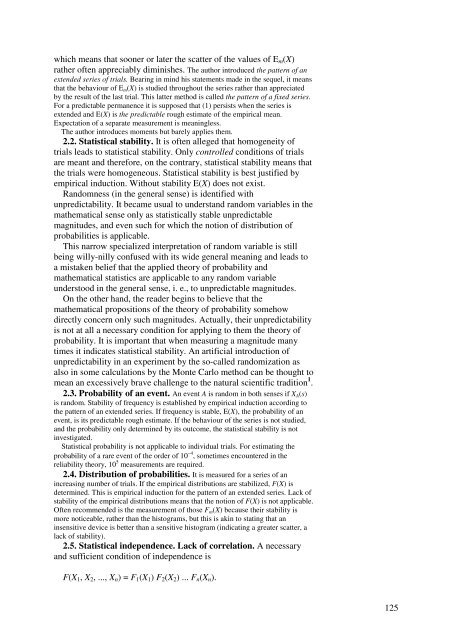1 Studies in the History of Statistics and Probability ... - Sheynin, Oscar
1 Studies in the History of Statistics and Probability ... - Sheynin, Oscar
1 Studies in the History of Statistics and Probability ... - Sheynin, Oscar
Create successful ePaper yourself
Turn your PDF publications into a flip-book with our unique Google optimized e-Paper software.
which means that sooner or later <strong>the</strong> scatter <strong>of</strong> <strong>the</strong> values <strong>of</strong> E m (X)ra<strong>the</strong>r <strong>of</strong>ten appreciably dim<strong>in</strong>ishes. The author <strong>in</strong>troduced <strong>the</strong> pattern <strong>of</strong> anextended series <strong>of</strong> trials. Bear<strong>in</strong>g <strong>in</strong> m<strong>in</strong>d his statements made <strong>in</strong> <strong>the</strong> sequel, it meansthat <strong>the</strong> behaviour <strong>of</strong> E m (X) is studied throughout <strong>the</strong> series ra<strong>the</strong>r than appreciatedby <strong>the</strong> result <strong>of</strong> <strong>the</strong> last trial. This latter method is called <strong>the</strong> pattern <strong>of</strong> a fixed series.For a predictable permanence it is supposed that (1) persists when <strong>the</strong> series isextended <strong>and</strong> E(X) is <strong>the</strong> predictable rough estimate <strong>of</strong> <strong>the</strong> empirical mean.Expectation <strong>of</strong> a separate measurement is mean<strong>in</strong>gless.The author <strong>in</strong>troduces moments but barely applies <strong>the</strong>m.2.2. Statistical stability. It is <strong>of</strong>ten alleged that homogeneity <strong>of</strong>trials leads to statistical stability. Only controlled conditions <strong>of</strong> trialsare meant <strong>and</strong> <strong>the</strong>refore, on <strong>the</strong> contrary, statistical stability means that<strong>the</strong> trials were homogeneous. Statistical stability is best justified byempirical <strong>in</strong>duction. Without stability E(X) does not exist.R<strong>and</strong>omness (<strong>in</strong> <strong>the</strong> general sense) is identified withunpredictability. It became usual to underst<strong>and</strong> r<strong>and</strong>om variables <strong>in</strong> <strong>the</strong>ma<strong>the</strong>matical sense only as statistically stable unpredictablemagnitudes, <strong>and</strong> even such for which <strong>the</strong> notion <strong>of</strong> distribution <strong>of</strong>probabilities is applicable.This narrow specialized <strong>in</strong>terpretation <strong>of</strong> r<strong>and</strong>om variable is stillbe<strong>in</strong>g willy-nilly confused with its wide general mean<strong>in</strong>g <strong>and</strong> leads toa mistaken belief that <strong>the</strong> applied <strong>the</strong>ory <strong>of</strong> probability <strong>and</strong>ma<strong>the</strong>matical statistics are applicable to any r<strong>and</strong>om variableunderstood <strong>in</strong> <strong>the</strong> general sense, i. e., to unpredictable magnitudes.On <strong>the</strong> o<strong>the</strong>r h<strong>and</strong>, <strong>the</strong> reader beg<strong>in</strong>s to believe that <strong>the</strong>ma<strong>the</strong>matical propositions <strong>of</strong> <strong>the</strong> <strong>the</strong>ory <strong>of</strong> probability somehowdirectly concern only such magnitudes. Actually, <strong>the</strong>ir unpredictabilityis not at all a necessary condition for apply<strong>in</strong>g to <strong>the</strong>m <strong>the</strong> <strong>the</strong>ory <strong>of</strong>probability. It is important that when measur<strong>in</strong>g a magnitude manytimes it <strong>in</strong>dicates statistical stability. An artificial <strong>in</strong>troduction <strong>of</strong>unpredictability <strong>in</strong> an experiment by <strong>the</strong> so-called r<strong>and</strong>omization asalso <strong>in</strong> some calculations by <strong>the</strong> Monte Carlo method can be thought tomean an excessively brave challenge to <strong>the</strong> natural scientific tradition 1 .2.3. <strong>Probability</strong> <strong>of</strong> an event. An event A is r<strong>and</strong>om <strong>in</strong> both senses if X A (s)is r<strong>and</strong>om. Stability <strong>of</strong> frequency is established by empirical <strong>in</strong>duction accord<strong>in</strong>g to<strong>the</strong> pattern <strong>of</strong> an extended series. If frequency is stable, E(X), <strong>the</strong> probability <strong>of</strong> anevent, is its predictable rough estimate. If <strong>the</strong> behaviour <strong>of</strong> <strong>the</strong> series is not studied,<strong>and</strong> <strong>the</strong> probability only determ<strong>in</strong>ed by its outcome, <strong>the</strong> statistical stability is not<strong>in</strong>vestigated.Statistical probability is not applicable to <strong>in</strong>dividual trials. For estimat<strong>in</strong>g <strong>the</strong>probability <strong>of</strong> a rare event <strong>of</strong> <strong>the</strong> order <strong>of</strong> 10 −4 , sometimes encountered <strong>in</strong> <strong>the</strong>reliability <strong>the</strong>ory, 10 5 measurements are required.2.4. Distribution <strong>of</strong> probabilities. It is measured for a series <strong>of</strong> an<strong>in</strong>creas<strong>in</strong>g number <strong>of</strong> trials. If <strong>the</strong> empirical distributions are stabilized, F(X) isdeterm<strong>in</strong>ed. This is empirical <strong>in</strong>duction for <strong>the</strong> pattern <strong>of</strong> an extended series. Lack <strong>of</strong>stability <strong>of</strong> <strong>the</strong> empirical distributions means that <strong>the</strong> notion <strong>of</strong> F(X) is not applicable.Often recommended is <strong>the</strong> measurement <strong>of</strong> those F m (X) because <strong>the</strong>ir stability ismore noticeable, ra<strong>the</strong>r than <strong>the</strong> histograms, but this is ak<strong>in</strong> to stat<strong>in</strong>g that an<strong>in</strong>sensitive device is better than a sensitive histogram (<strong>in</strong>dicat<strong>in</strong>g a greater scatter, alack <strong>of</strong> stability).2.5. Statistical <strong>in</strong>dependence. Lack <strong>of</strong> correlation. A necessary<strong>and</strong> sufficient condition <strong>of</strong> <strong>in</strong>dependence isF(X 1 , X 2 , ..., X n ) = F 1 (X 1 ) F 2 (X 2 ) ... F n (X n ).125









